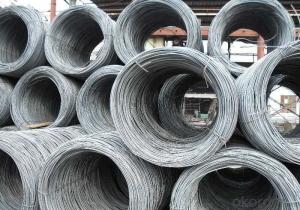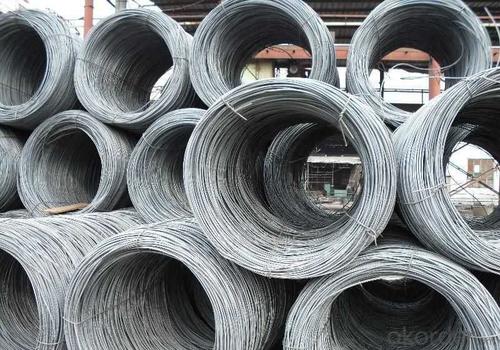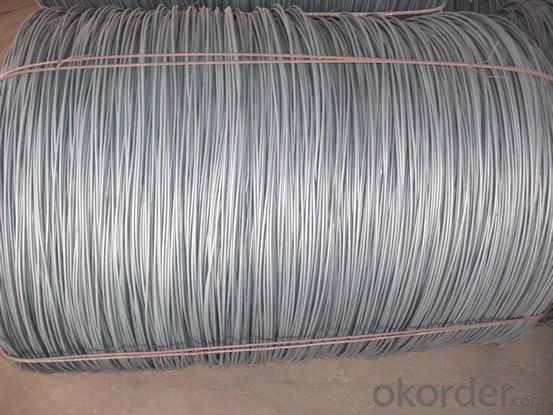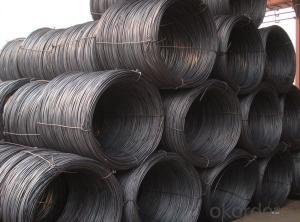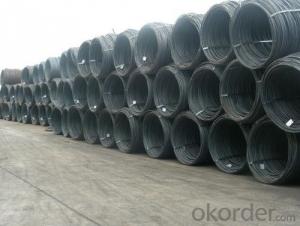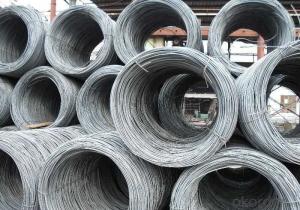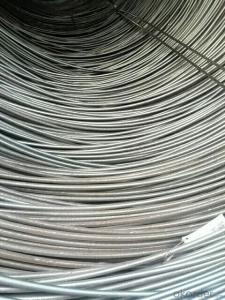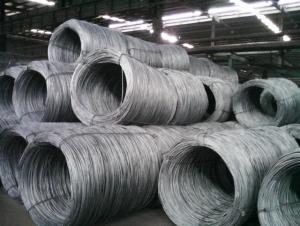Hot rolled steel wire rod 5.5mm-14mm SAE1006-1018B
- Loading Port:
- Tianjin
- Payment Terms:
- TT OR LC
- Min Order Qty:
- 25 m.t.
- Supply Capability:
- 1000000 m.t./month
OKorder Service Pledge
OKorder Financial Service
You Might Also Like
WIRE ROD Details:
| Minimum Order Quantity: | m.t. | Unit: | m.t. | Loading Port: | |
| Supply Ability: | m.t./month | Payment Terms: | TT OR LC |
Product Description:
Steel Grade: Q195 Standard: ASTM, GB
Diameter: 5.5mm, 6.5mm, 7mm,8mm,9mm,10mm,12mm,14mm
6.5mm can be drawing into 2mm/8.0mm can be drawing into 3mm
Type: Drawn Wire in Coil, each coil weight about 2MT
Brand Name: N-RIVER Place of Origin: Hebei, China
Chemical Composition:
Please kindly find our chemistry of our material based on Q195 as below for your information
Trademark | Rank | Chemical composition (quality score) % | |||||
C | Si | Mn | S | P | |||
| ≤ |
| ≤ | ≤ | |||
Q195 |
| 0.06-0.12 | 0.30 | 0.25 | 0.050 | 0.045 | |
Trademark | Rank | Pulling Test | |||||
Bend PointΔs/Mpa | Tensile Strength | Elongation Ratioδ5% | |||||
Thickness (Diameter) /MM | Thickness (Diameter) /MM | ||||||
≤16 | 16-40 | ≤16 | 16-40 | ||||
≥ | ≥ | ||||||
Q195 |
| 195 | 185 | 315-390 | 33 | 32 | |
Usage and Applications of Wire Rod Q195:
After hot-rolled the products shaped into coil and delivery as finished product, including round, square, rectangular, hexagonal and so on. Since most of the products are round, it is generally called wire rod. Carbon steel wire rod is widely used in construction and manufacturing. Carbon steel wire rod is mainly used for reinforcement of reinforced concrete and welded structure or reprocessed (roberts , nail, etc.) materials, especially used to produce wire drawing, welding electrode, nails, spring, electronic, precise machinery parts and so on
- Q: Can steel wire rod be used in high-temperature applications?
- Yes, steel wire rod can be used in high-temperature applications. Steel has excellent heat-resistant properties and can withstand high temperatures without losing its strength or structural integrity. However, the specific grade and composition of the steel wire rod should be considered to ensure it is suitable for the intended high-temperature environment.
- Q: How does the fatigue strength of steel wire rod vary with different heat treatment processes?
- The fatigue strength of steel wire rod can vary with different heat treatment processes. Heat treatment processes like annealing, quenching, and tempering can significantly affect the microstructure and mechanical properties of steel wire rod, including its fatigue strength. Annealing, for example, can help reduce internal stresses and improve the ductility of the wire rod, thus potentially increasing its fatigue strength. Quenching and tempering, on the other hand, can enhance the hardness and strength of the wire rod, but may also result in reduced ductility and potentially lower fatigue strength. Therefore, the specific heat treatment process used on steel wire rod can have a significant impact on its fatigue strength.
- Q: What are the common production processes for actinium-coated steel wire rod?
- The common production processes for actinium-coated steel wire rod generally include wire drawing, cleaning, coating, curing, and packaging.
- Q: What are the regulations governing the production and use of steel wire rod?
- The regulations governing the production and use of steel wire rod vary by country and region. However, some common regulations include quality standards, safety requirements, and environmental regulations. These regulations aim to ensure that steel wire rod is produced and used in a safe and environmentally responsible manner, while also meeting the required quality standards.
- Q: What are the main factors affecting the product differentiation of steel wire rod?
- The main factors affecting the product differentiation of steel wire rod are the chemical composition and quality of the steel used, the manufacturing process and technology employed, the size and shape options available, the surface finish and treatment, and any additional features or value-added services provided by the manufacturer.
- Q: What are the challenges faced by the steel wire rod manufacturers?
- Some of the challenges faced by steel wire rod manufacturers include fluctuating raw material prices, intense competition in the market, stringent environmental regulations, and the need for continuous technological advancements to improve product quality and efficiency. Additionally, the industry also faces challenges related to transportation logistics, maintaining a skilled workforce, and managing supply chain complexities.
- Q: What are the different types of heat treatments used for steel wire rod?
- Steel wire rods undergo various heat treatments to achieve specific properties and benefits. The most commonly used treatments include: 1. Annealing: The steel wire rod is heated to a specific temperature and gradually cooled to enhance its ductility, reduce internal stresses, and refine its microstructure. This improves its workability and mechanical properties. 2. Quenching and tempering: By rapidly cooling the heated steel wire rod, it becomes hardened with increased strength and hardness. Subsequently, tempering involves reheating the quenched steel at a lower temperature to enhance toughness, reduce brittleness, while retaining some of the hardness. 3. Normalizing: Similar to annealing, normalizing involves heating the steel wire rod to a specific temperature and allowing it to cool in still air. This refines the grain structure, improves strength and toughness, and eliminates internal stresses. 4. Stress relieving: Residual stresses accumulated during previous manufacturing processes are reduced through this heat treatment. By heating the rod to a specific temperature and cooling it slowly, stress relieving prevents material distortion or cracking. 5. Case hardening: Also known as carburizing, this treatment increases the hardness and wear resistance of the steel wire rod. Carbon is introduced into the surface layer by heating it in a carbon-rich atmosphere, followed by quenching to achieve the desired hardness. The selection of heat treatment for steel wire rods depends on the desired properties and applications of the final product. Each treatment method offers distinct advantages and is chosen based on the specific requirements of the wire rod.
- Q: What are the common alloying elements used in steel wire rod?
- The common alloying elements used in steel wire rod include carbon, manganese, silicon, and sometimes small amounts of other elements such as chromium, nickel, and vanadium.
- Q: How is steel wire rod used in the production of wire for brush bristles?
- Steel wire rod is an essential material in the production of wire for brush bristles. Wire rod serves as the primary raw material that is used to manufacture the wires needed for brush bristles. To begin the production process, steel wire rod is first selected based on its specific properties, such as strength, flexibility, and durability. The chosen rod is then processed through a series of manufacturing steps to transform it into the desired wire for brush bristles. The first step involves drawing the steel wire rod through a series of dies, which gradually reduce its diameter while increasing its length. This process is known as wire drawing and is repeated multiple times to achieve the desired thickness and strength of the wire. After wire drawing, the wire is further processed to improve its properties. This may include heat treatment to enhance its strength and flexibility, or surface treatments like galvanization or coating to provide corrosion resistance. Once the wire has undergone these treatments, it is then cut into lengths suitable for brush bristles. At this stage, the wire can be further manipulated to develop specific brush bristle characteristics. For example, the wire may be twisted or crimped to enhance its cleaning or brushing capabilities. Finally, the wire is attached to the brush base or handle to complete the production of brush bristles. The wires are typically secured using specialized machinery or techniques such as stapling or binding. In summary, steel wire rod plays a crucial role in the production of wire for brush bristles. It serves as the basic material that undergoes various manufacturing processes, including wire drawing, heat treatment, and surface treatments, to transform it into the required wire for brush bristles.
- Q: How are steel wire rods used in the manufacturing of piano strings?
- Steel wire rods are used in the manufacturing of piano strings as they provide the necessary strength and flexibility required for producing high-quality and durable strings.
Send your message to us
Hot rolled steel wire rod 5.5mm-14mm SAE1006-1018B
- Loading Port:
- Tianjin
- Payment Terms:
- TT OR LC
- Min Order Qty:
- 25 m.t.
- Supply Capability:
- 1000000 m.t./month
OKorder Service Pledge
OKorder Financial Service
Similar products
Hot products
Hot Searches
Related keywords
